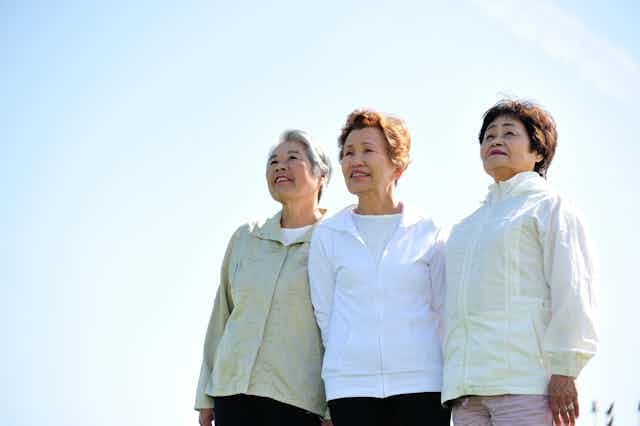This article is part of our series examining women’s hidden health conditions. You can read about bacterial vaginosis, pelvic inflammatory disease and other pieces in the series here.
It’s a sensation familiar to three out of every four women going through menopause. First, there’s a sudden and intense feeling of heat, accompanied by extreme sweating and redness in the face and chest. This is followed by chills. Then, it’s repeated several times an hour around the clock.
An estimated one million Australian women suffer hot flushes, and suffer they do. They don’t just leave women feeling hot and bothered, but also have considerable impact on quality of life.
Hot flush episodes go on for an average of three to four minutes at a time. For some women, they can last up to an hour.
Flushes aren’t usually a transient experience either. They persist for an average of five to seven years. About 40% of women will still experience them into their early 60s.
Despite this high prevalence, women usually suffer alone, breaking their silence only with close girlfriends or partners.
Social attitudes around menopause need to shift toward valuing the experience and maturity that comes with ageing. This will inevitably reduce the menopausal distress women experience.
Avoiding social interactions
Patients have told me they avoided social interactions because they’ve been embarrassed about their hot flushes, which over time led to depression. Some said they avoided shopping because they feared being mistaken for a shoplifter – as the sweating and red face made them appear nervous and guilty.
Women have told me their symptoms were ruining their lives and they were at the absolute end of their tether. Studies have backed this anecdotal evidence, showing hot flushes left many women feeling embarrassed, physically unattractive and stupid.

Women across the world experience menopausal symptoms differently. In China, for instance, the prevalence of hot flushes is relatively low, at around 20% to 30%.
While biological differences may certainly play a role, there are suggestions cultural differences shape these experiences. One study showed Chinese women viewed ageing positively; some felt it signalled a time of wisdom and maturity.
By contrast, in the West, menopause conjures up themes around loss of femininity, beauty and sexuality. Such negative cultural attitudes could contribute to the severity of hot flushes experienced by Western women.
Menopause in the workforce
Hot flushes and other menopausal symptoms, including sleep disturbance and memory loss, can have a considerable impact on women at work. This is highly relevant as women of menopausal age comprise 17% of the Australian workforce.
A large Australian study on menopausal women in the workplace found many felt stressed and anxious at work, which led to poor self-esteem and loss of confidence. Some said their symptoms made them lose concentration and focus.
Unfortunately, it also showed managers and human resources staff weren’t skilled at effectively managing menopausal staff. Women reported “gendered ageism”, such as feeling “invisible” once they reached menopausal age. Some felt they had been overlooked for promotions and other opportunities because they were viewed as no longer intellectually desirable.
A study from the United Kingdom reported criticism and even harassment directed at women taking menopause-related sick leave.
Positively though, the study outlined strategies women found helpful at their place of work. These included having control over ambient temperature, access to cold water and toilets, and understanding from managers about menopause-related sick leave and flexibility of working hours.
Treatment options
Hormone replacement therapy (HRT) is effective for relieving menopausal symptoms, with studies showing up to a 75% reduction in frequency compared to placebo.
But new research suggests that despite its effectiveness and although it’s safe for many women, particularly those under 60, HRT is significantly underused. This means the majority of women suffering from severe hot flushes remain untreated.

Some women find complementary therapies, such as acupuncture, help relieve symptoms. But trials testing the effectiveness of these therapies have been conflicting. Our recent study, for instance, showed acupuncture was as effective as sham acupuncture for relieving hot flushes.
Strategies other women find helpful are: layering of clothing, such as removing a cardigan when a flush happens; avoiding triggers such as hot drinks, and psychological techniques such as communicating with openness and humour.
Mind-body interventions such as meditation may help, and there is growing interest among researchers and clinicians in the role of cognitive behavioural therapy.
The increasing evidence for the effectiveness of psychological techniques strengthens the idea that social attitudes and perceptions of the condition can impact its severity.
A positive experience
Actress Angelina Jolie’s decision to remove both her ovaries and therefore enter menopause was heralded as a milestone. It was a time when Hollywood, and indeed society, was finally forced to have a conversation about menopause.
It takes a beautiful young celebrity facing the risk of breast cancer for society to finally bring up this last taboo.
There are positives of going through menopause. Women speak of a new independence from menstruation and worrying about birth control. It can be an empowering life stage if a cultural shift leads to awareness, support, and open and honest communication.
Organisations should recognise menopause as an occupational issue and build capacity to support women through this difficult transition. Menopause must become normalised as a natural and commonly occurring event.
Carolyn will be on hand for an Author Q&A between 12 and 12:30pm AEDT on Friday, 12 February, 2016. Post your questions in the comments section below.

